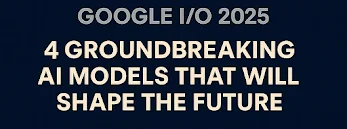At Google I/O 2025, the company raised the bar for artificial intelligence yet again by launching four revolutionary AI models. These are not just incremental upgrades — they mark a transformative leap forward in how machines see, hear, speak, and create. The newly unveiled models—Gemini, Veo, Imagen 3, and Project Astra—showcase Google’s ambition to lead the future of AI innovation across language, video, imagery, and real-time assistance.
Let’s break down each of these models and what makes them so powerful:
🌟 1. Gemini: The Flagship Conversational AI of 2025
Gemini, Google’s next-generation language model, is designed to be faster, smarter, and more intuitive than anything that’s come before.
🔍 Key Features:
- Multimodal capability: Understands not just text, but also images, video, and audio.
- Advanced memory: It can retain context across longer conversations, making it ideal for research, planning, and even coding support.
- Creative and analytical: From poetry and storytelling to solving math problems and writing code, Gemini adapts its tone and reasoning based on your prompt.
🔧 Use Cases:
- Personal assistants
- Educational tutors
- Customer service bots
- Developer copilots
🎬 2. Veo: Text-to-Video Like Never Before
Veo is Google’s answer to the growing demand for AI-generated video content. It’s designed to take simple text prompts and turn them into cinematic-quality video clips.
🔍 Key Features:
- Text-to-video synthesis: Describe a scene, and Veo brings it to life.
- Scene control: Users can adjust mood, lighting, angle, and even motion through natural language commands.
- High fidelity & realism: Videos feel professionally shot, complete with depth, transitions, and real-world textures.
🎥 Use Cases:
- Content creation for social media, marketing, or education
- Film pre-visualization
- Storyboarding for creatives
🖼️ 3. Imagen 3: The Next-Level Image Generator
Building on the success of Imagen 1 and 2, Imagen 3 is Google’s most powerful text-to-image model to date.
🔍 Key Features:
- Insanely detailed photorealistic image generation
- Understands complex prompts and can interpret abstract concepts
- Improves on hands, faces, and text rendering, traditionally weak points for image generator
🧠 Use Cases:
- Ad campaigns and product mockups
- Visual storytelling and illustrations
- Fashion design, architecture, and digital art
🧠 4. Project Astra: Real-Time, Vision-Enabled AI Assistant
Think of Project Astra as Google’s vision for an all-seeing, always-aware digital assistant. It processes visual and audio inputs in real time, enabling context-aware AI experiences unlike anything available today.
🔍 Key Features:
- Multimodal fusion: Combines what it sees (camera), hears (microphone), and reads (text) to respond instantly.
- Real-time performance: Can identify objects, understand questions based on its surroundings, and give live feedback.
- Edge computing-ready: Optimized to work not just in the cloud, but also on mobile and AR devices.
🧠 Use Cases:
- Smart glasses or AR experiences
- Real-time help while cooking, repairing, or learning
- Vision-impaired assistance tools
🔮 What This Means for the Future
With these four models, Google is blurring the line between science fiction and reality. The convergence of text, vision, video, and real-time perception into unified AI systems means we are entering an era where machines can understand and interact with the world as humans do—but faster, more consistently, and at scale.
Whether you’re a creator, developer, business owner, or just a tech enthusiast, these tools are about to unlock possibilities that were unthinkable just a few years ago.
📌 Final Thoughts
Google I/O 2025 proves that the AI race is far from over — it’s just entering a more immersive and intelligent phase. With Gemini, Veo, Imagen 3, and Project Astra, Google isn’t just innovating — it’s redefining the AI experience for everyone.

Post a Comment